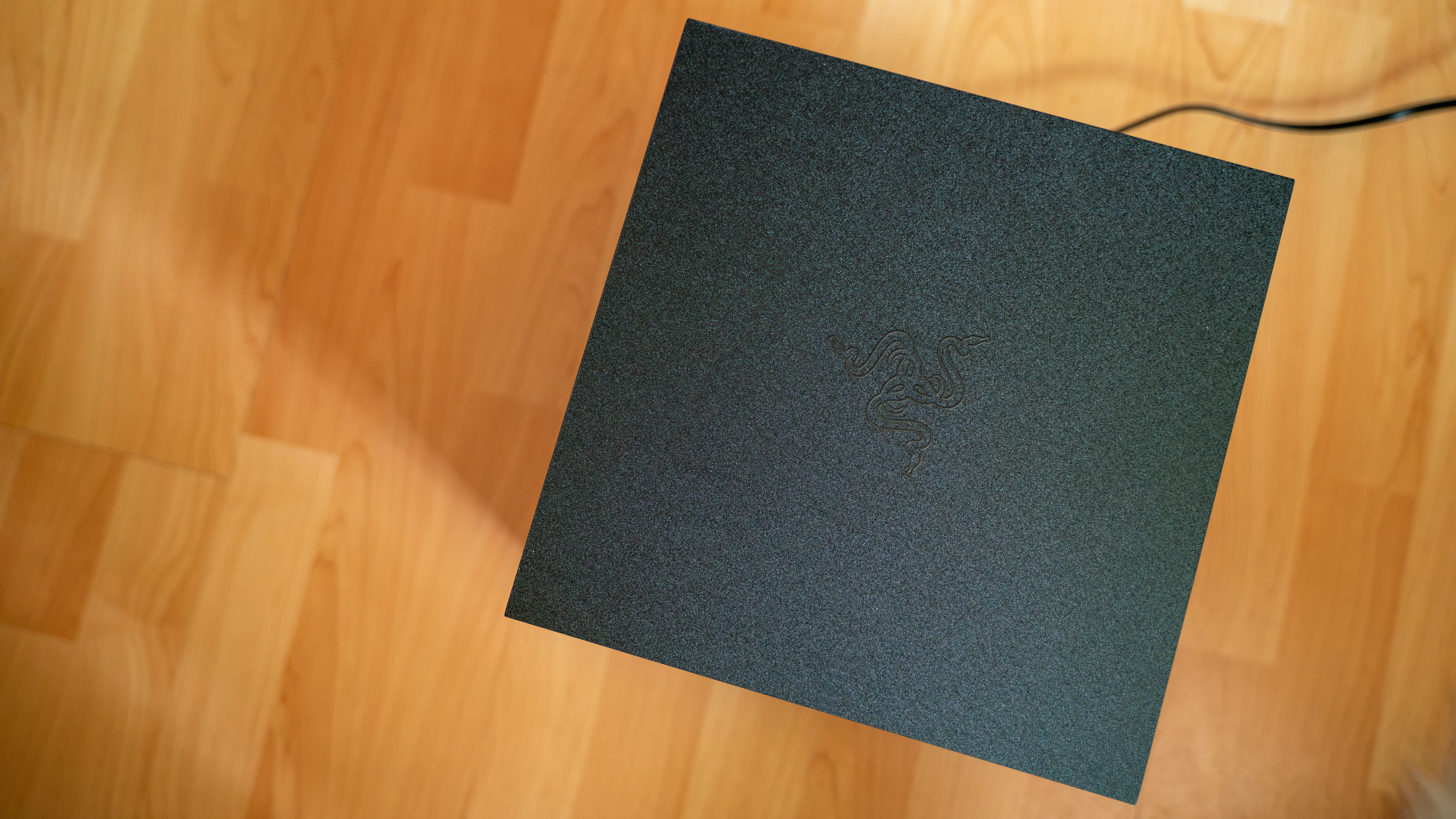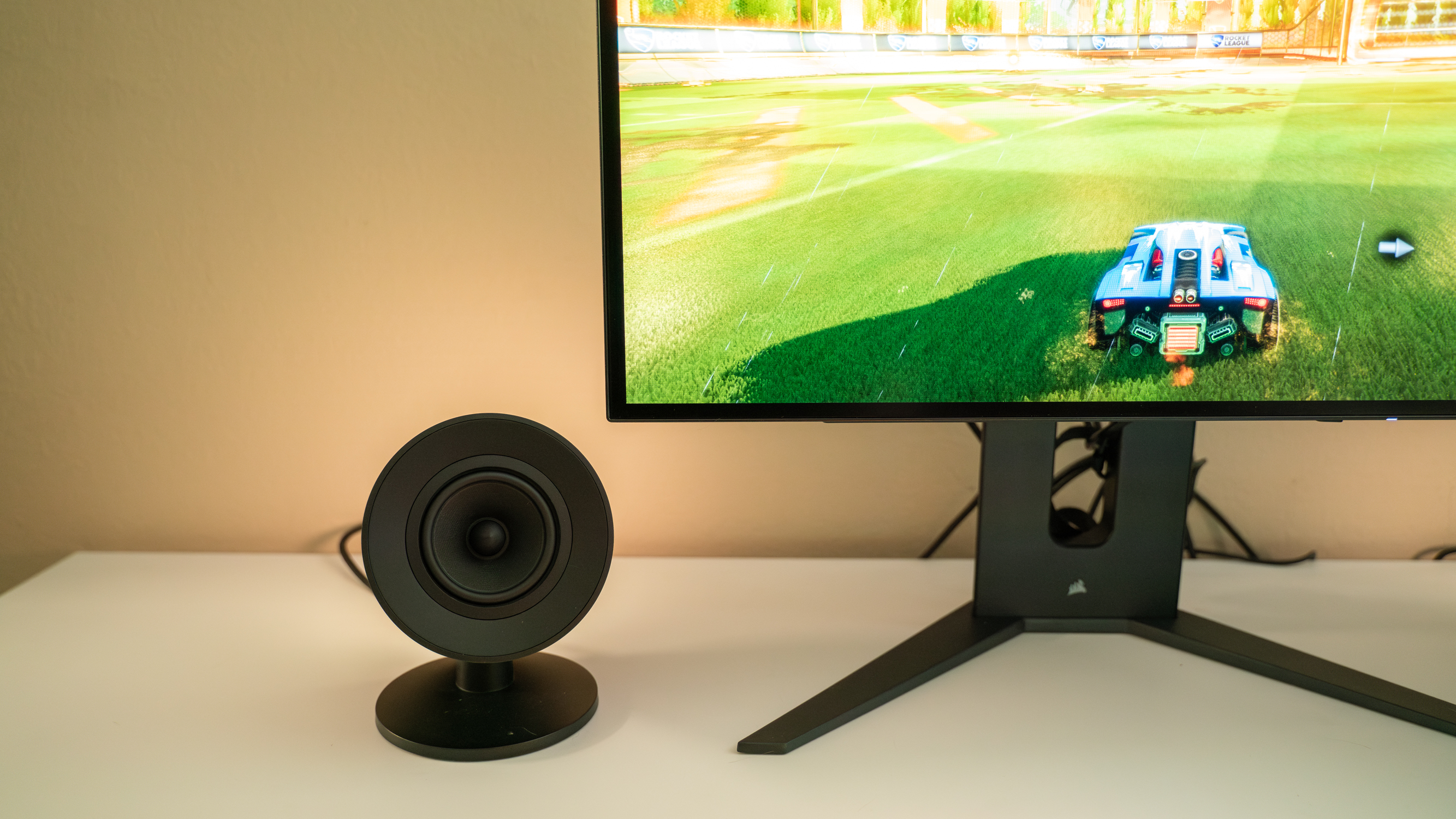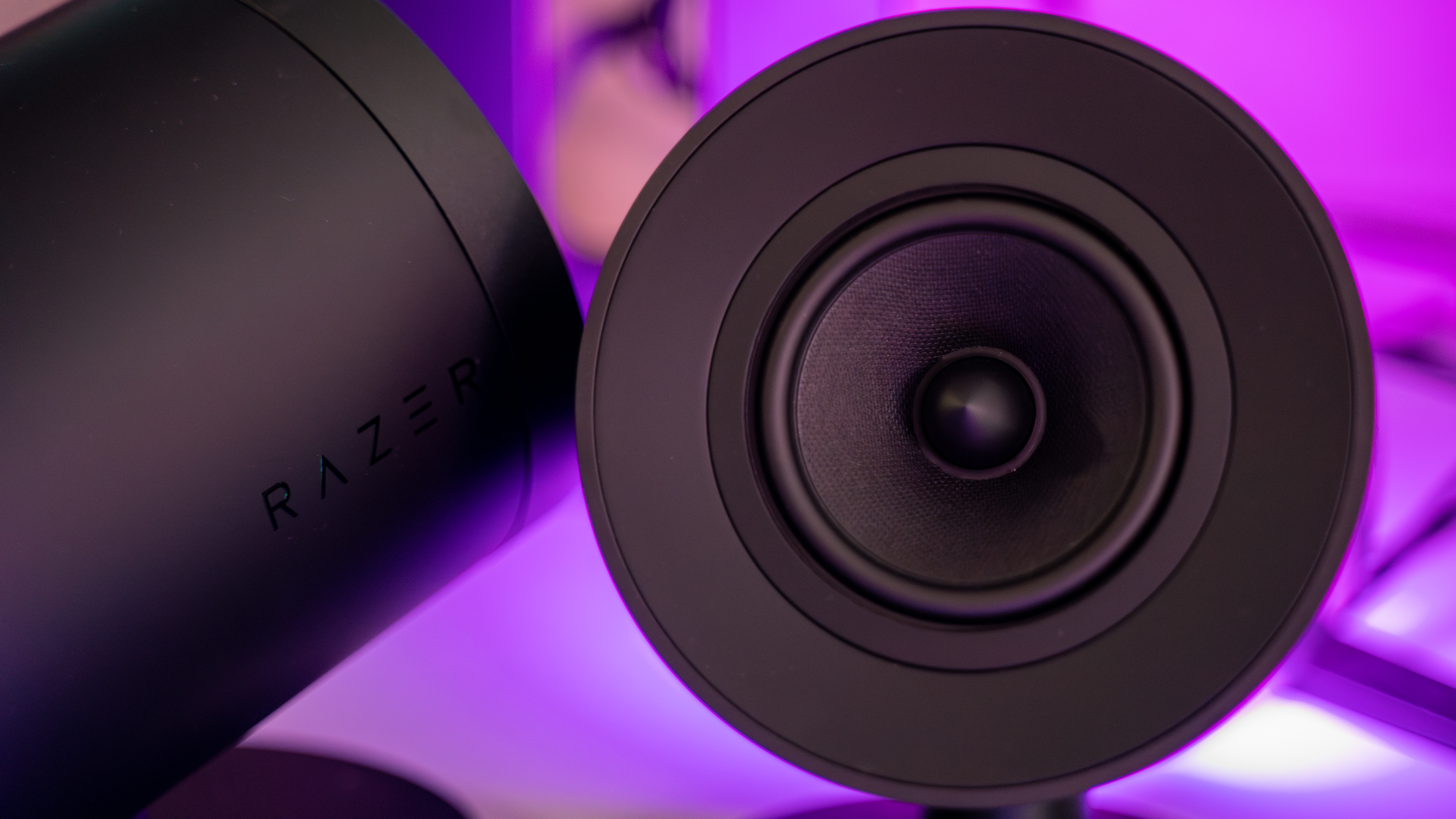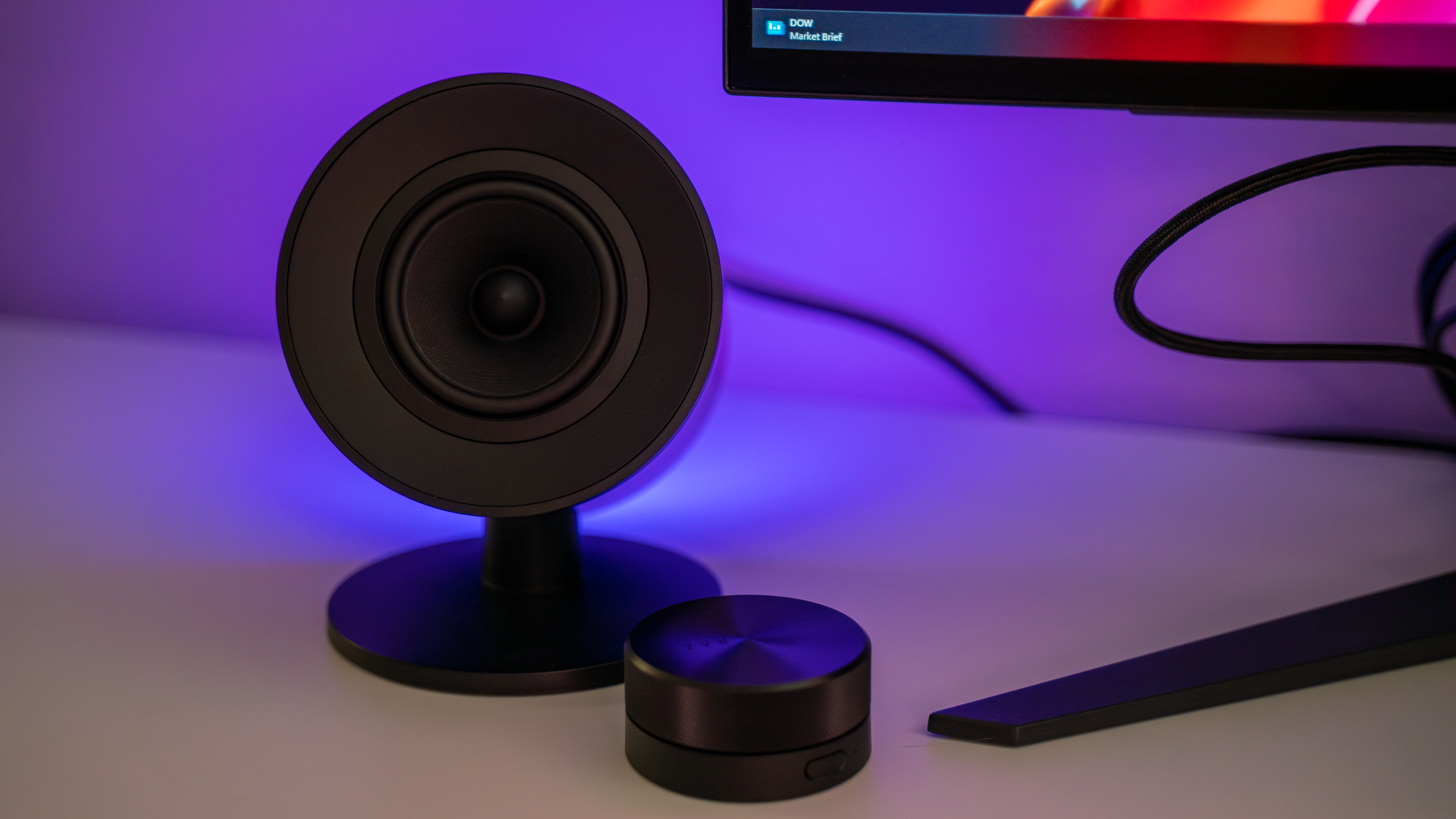Razer Nommo V2 Pro: Two-minute review
It lowkey broke my heart when I had to return our on-loan review unit of the original Razer Nommo Pro. Those speakers were truly incredible, and while there have been amazing releases that followed, very few have surpassed them. They left such massive shoes to fill, in fact, that I was starting to think that Razer wasn’t going to follow up with a new model.
Luckily, you can always count on Razer looking to outdo itself, and that’s exactly what it’s done with the Razer Nommo V2 Pro. I didn’t think it was possible, but this successor to Razer’s best PC speakers yet is even better than the OG – it’s better sounding, more powerful, and more immersive while taking up a bit less space on your desk.
It’s even more formidable than the impressive Razer Leviathan V2 Pro, which packs a subwoofer already so powerful, my neighbors asked me one night to turn it down – when it was only at 15% volume. I don’t want to know what they think of me now that the Nommo V2 Pro has taken over.

Besides that room-shaking, downward-firing sub, you’re also getting two satellite speakers, just like the first model. But while that one championed cylindrical shapes, this new one has swapped out the old rounded subwoofer with a square one and trimmed the top cylinders that housed the tweeters off the satellites for good measure
I wouldn’t call the Nommo V2 Pro compact, but the whole system certainly takes up less space as a result of the design shift, which is nice. It also has fewer cables, especially since the control pod is no longer tethered, being fully wireless, which means less eyesore on your desk.
Speaking of the control pod, it’s fully customizable and supports other compatible Razer peripherals. If you’ve got a whole suite of Razer gaming peripherals on your gaming desk, you can use it to change settings like your mouse’s DPI, for instance, unifying control of your hardware setup under a single physical interface. Of course, it’s also reliable when performing its original intended function: controlling the Nommo V2 Pro.
Though connecting the Nommo V2 Pro to your PC or laptop via USB is the way to go, there is Bluetooth connectivity too, so you can use it with your phone, tablet, or Nintendo Switch as well.

Another noteworthy upgrade here is the ambient RGB lighting. Instead of the thin strip that wrapped around each Nommo Pro satellite’s stand, here you get a four-inch dome on the rear of the Nommo V2 Pro’s satellite’s. This allows each speaker to bounce RGB lighting off the wall behind them, effectively bathing your gaming setup with ambient lighting. It’s a much more effective approach, especially since you can set the lighting to be reactive to sound or whatever’s happening on your screen.
This ambient display awareness mode would be cooler if it was more accurate or brighter. For some reason, although the RGB zones are vibrant enough, they tend to dim a little when set to this reactive effect. It’s also not the most accurate when it’s supposed to mimic what’s on your screen, which is why I prefer to just use the other lighting effects Razer has on hand in the Chroma and Synapse apps. You can also layer lighting effects, which is the ideal way to go for the most vibrant results.
Speaking of the Synapse app, it comes in very handy so do be sure to install it to maximize the Razer Nommo V2 Pro’s features. There’s a 10-band EQ that lets you boost or cut each frequency to 12dB or choose from five presets (one being custom) if you are EQ-uninitiated.

It also has THX profiles on hand for some of the most popular games right now, including Cyberpunk 2077 and Hogwarts Legacy. By pre-selecting the THX Environmental Mode for those games, you’re telling the Nommo V2 Pro to automatically switch to that profile every time you start one of the games. It works like clockwork too – sometimes, you can actually hear it switch from whatever current sound profile you’re using to the THX mode during game loading.
However, in stereo mode with no EQ tweaking, the Nommo V2 Pro already sounds incredible. The highs are crisp and detailed while the mids are present, full, and not too rich so that it lends itself well to gaming. Thanks to that powerful downward-firing sub, you’re getting plenty of punchy bass and deep rumble.

Without the THX Spatial Audio, the soundstage is also already reasonably wide – though this is somewhat determined by your speaker placement – and the sound imaging is very good, allowing you to clearly hear where every audio element in a game is and if it’s moving.
That said, switching to the THX Spatial Audio makes a massive difference. It’s well-implemented here, as it makes everything sound wider and more immersive without sounding like Razer just added some artificial reverb.
There’s also plenty of volume on tap. And when I say plenty, I mean that if you set this to around 80%, you’re gonna want to sit a few feet away from your desk, lest you risk ear damage. I also highly suggest checking in with your roommates or neighbors if you’re planning on firing it up at night for a sesh – because trust me, you’re gonna want to.
Razer Nommo V2 Pro: Price & availability
- How much does it cost? $449.99
- When is it available? Available June 2023
- Where can you get it? Confirmed in the US
Another thing the Razer Nommo V2 Pro has over its predecessor is a slightly more accessible price tag. I wouldn’t call it a budget buy, but it’s a tad more affordable than the original at $449.99 in the US.
It’s also $150 cheaper than SteelSeries’ Arena 9, which will set you back a hefty $599 / €599 / AU$599 – although to be fair, that one is a 5.1 system, and if you compare the Nommo V2 Pro to its closest SteelSeries rival, the Arena 7, it’s actually pricier. It’s also more expensive than Razer’s PC soundbar system, the aforementioned Leviathan V2 Pro, which sits at $399.99 / £399.99 (about AU$600).
Still, if you want high-quality audio, you almost always have to pay more, and the Razer Nommo V2 Pro certainly offers better audio quality than the Arena 7 and the Leviathan V2 Pro.
If you are ready to invest in the Razer Nommo V2 Pro – and I honestly think you should – it will be available in the US in June 2023. I’m sure it will also be available for UK and Australian customers around the same time, but I have yet to confirm that.
Razer Nommo V2 Pro: Specs
| Frequency range: | 40Hz – 20KHz |
| Drivers: | 2x 3.2-inch, 1x 5.5-inch woofer |
| Supported Connectivity: | Bluetooth 5.3 |
| Audio Inputs: | USB |
| Outputs: | Sub via Bluetooth |
Should you buy the Razer Nommo V2 Pro?

| Value | It isn’t cheap, but its impressive audio and rumbling bass makes it worth the money. | 4.5 / 5 |
| Design | It’s not the smallest setup, but it is decently-sized. The wireless control pod is a nice touch, as is its RGB lighting. | 4.8 / 5 |
| Performance | It delivers fantastic audio quality, a powerful, room-shaking bass, and a terrific soundstage. | 5 / 5 |
| Avarage rating | The Razer Nommo V2 Pro is the best PC speaker system I’ve tested in 2023 so far. | 4.8 / 5 |
Buy it if…
Don’t buy it if…
Razer Nommo V2 Pro: Also consider
| Razer Nommo V2 Pro | Razer Leviathan V2 Pro | SteelSeries Arena 9 | |
|---|---|---|---|
| Price: | $449.99 | $399.99 / £399.99 (about AU$600) | $549 / €599 / AU$599 |
| Frequency range: | 40Hz – 20KHz | 40Hz – 20kHz | 35Hz – 20kHz |
| Drivers: | 2x 3.2-inch, 1x 5.5-inch woofer | 5x 2-inch full-range drives, 1x 5.25-inch downward firing sub | 3-inch woofers, ¾-inch tweeters (front satellites), 2.75-inch woofers, ¾-inch tweeters (rear satellites), 2x 2.75-inch woofer, ¾-inch silk dome tweeter (center satellite), 6.4-inch downward firing woofer (subwoofer) |
| Supported connectivity: | Bluetooth 5.3 | Bluetooth | Bluetooth |
| Audio inputs: | USB | USB | USB, Optical, Analog 3.5mm |
| Outputs: | Sub via Bluetooth | 3.5mm | Optical passthrough, Analog 3.5mm |
How I tested the Razer Nommo V2 Pro
- Tested the Razer Nommo V2 Pro for several days
- Used it for gaming and streaming
- Tested the sound quality, volume, soundstage, and features
I used the Razer Nommo V2 Pro as my main PC speakers for a few days. Besides using it to play titles like Cyberpunk 2077, Hogwarts Legacy, and Rocket League, I also used it to watch movies and listen to tunes.
I’ve been testing, reviewing, and using audio devices for years as a freelance tech journalist and now as one of the Computing editors at TechRadar. My years of experience along with my discerning audio tastes make me more than qualified to test and vet these devices for you.
First reviewed May 2023





